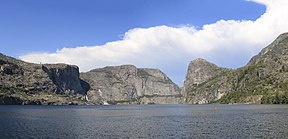| Hetch Hetchy Valley | |
|---|---|
Top: Taken in the early 1900s before the O'Shaughnessy Dam was constructed, shows the Hetch Hetchy Valley and the Tuolumne River, looking east. Wapama Falls is on the left, Kolana Rock on the right. Bottom: A modern photo, taken from much the same vantage point, shows the submergence of the valley floor under the waters of the reservoir. | |
| Floor elevation | 3,783 ft (1,153 m)[1] |
| Length | 3 mi (4.8 km) |
| Width | 0.5 mi (0.80 km) |
| Area | 1,200 acres (490 ha) |
| Depth | 1,800 ft (550 m) |
| Geology | |
| Type | Glacial |
| Age | 10,000–15,000 years |
| Geography | |
| Location | Yosemite National Park, California, United States |
| Coordinates | 37°56′53″N 119°47′17″W / 37.94806°N 119.78806°W [1] |
| River | Tuolumne River |
Hetch Hetchy is a valley, reservoir, and water system in California in the United States. The glacial Hetch Hetchy Valley lies in the northwestern part of Yosemite National Park and is drained by the Tuolumne River. For thousands of years before the arrival of settlers from the United States in the 1850s, the valley was inhabited by Native Americans who practiced subsistence hunting-gathering.
During the late 19th century, the valley was renowned for its natural beauty – often compared to that of Yosemite Valley – but also targeted for the development of water supply for irrigation and municipal interests. The controversy over damming Hetch Hetchy became mired in the political issues of the day. The law authorizing the dam passed Congress on December 7, 1913. In 1923, the O'Shaughnessy Dam was completed on the Tuolumne River, flooding the entire valley under the Hetch Hetchy Reservoir.[2] The dam and reservoir are the centerpiece of the Hetch Hetchy Project, which in 1934 began to deliver water 167 miles (269 km) west to San Francisco and its client municipalities in the greater San Francisco Bay Area.
- ^ a b "Hetch Hetchy Valley". Geographic Names Information System. United States Geological Survey, United States Department of the Interior. 1990-08-01. Retrieved 2013-05-26.
- ^ "Hetch Hetchy". San Francisco Water Power Sewer. Retrieved 2013-05-23.

